Recent Posts
Fire Safety Tips for Electrical Outlets
3/21/2025 (Permalink)
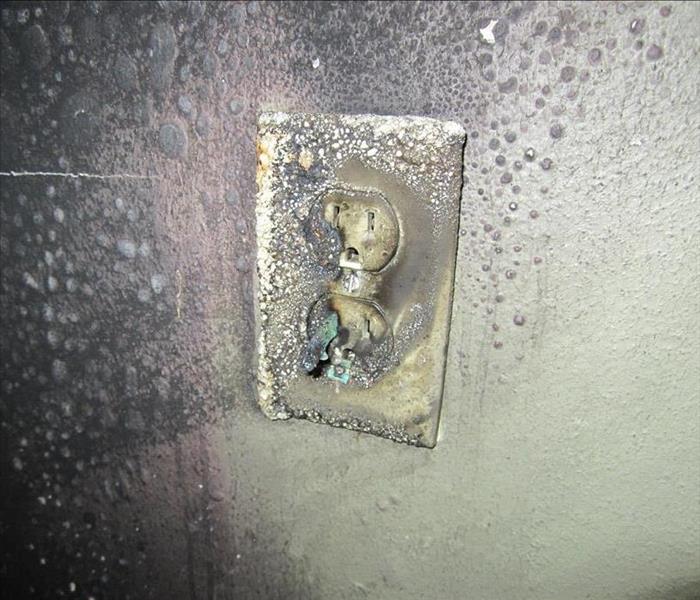 This faulty electrical outlet was the source of this house fire.
This faulty electrical outlet was the source of this house fire.
Electrical outlets are a part of our daily lives — charging phones, powering appliances, and keeping our homes running. But did you know that outlets can also be a hidden fire hazard if they are improperly maintained? At SERVPRO of Lufkin/Nacogdoches, we're not just here to restore fire damage — we're here to help prevent it too.
Fire Safety Tips for Electrical Outlets:
Don't overload outlets: Plugging too many devices into one outlet can cause overheating. Use power strips with surge protectors if you need extra plug space.
Check for Damage: Cracked or discolored outlets could indicate electrical issues. If you notice any, have a licensed electrician inspect them.
Upgrade Old Outlets: If your home is older, consider upgrading to outlets with built-in surge protection or GFCI (Ground Fault Circuit Interrupter) outlets, especially in kitchens and bathrooms.
Unplug When Not in Use: Appliances and chargers still draw power when plugged in. Unplug unused devices to reduce fire risk.
Childproof Your Outlets: If you have little ones at home, use outlet covers to prevent curious fingers from poking inside.
Signs of Electrical Problems:
Being proactive about fire safety starts with small habits and regular checks. But if the unexpected happens, know that SERVPRO of Lufkin/Nacogdoches is just a call away — ready to respond quickly and help you recover.
Stay safe, and stay prepared!
Our commercial cleaning services cover a wide range of needs.
3/16/2025 (Permalink)
 Another happy customer after our team has completed this commercial deep cleaning.
Another happy customer after our team has completed this commercial deep cleaning.
At SERVPRO of Lufkin/Nacogdoches, we do more than just disaster recovery — we're your go-to team for top-notch cleaning services, too! Whether it’s a deep clean for your home, a post-construction cleanup, or preparing a commercial space for reopening, we have the expertise and equipment to handle it all.
Our cleaning services cover a wide range of needs, including:
Carpet and Upholstery Cleaning: Say goodbye to stubborn stains and odors with our professional-grade equipment.
Air Duct and HVAC Cleaning: Improve indoor air quality by removing dust, allergens, and contaminants.
Odor Removal and Deodorization: We eliminate lingering smells at the source using advanced technology.
Biohazard and Crime Scene Cleanup: Our team is trained to handle sensitive situations with care and professionalism.
Ceiling, Floor, and Wall Cleaning: No corner goes untouched — we tackle grime and buildup in even the hardest-to-reach places.
We know how vital a clean space is for both comfort and health. We tailor our services to fit your needs, ensuring every nook and cranny shines.
When you choose SERVPRO, you're not just getting a cleaning service — you're getting a trusted partner who cares as much about your home or business as you do.
Let us help you make your space look (and smell) its best. Contact SERVPRO of Lufkin/Nacogdoches today for a customized cleaning plan that works for you!
SERVPRO of Lufkin Roof-Tarp and Board-Up Services: Protecting Your Property After a Storm
2/25/2025 (Permalink)
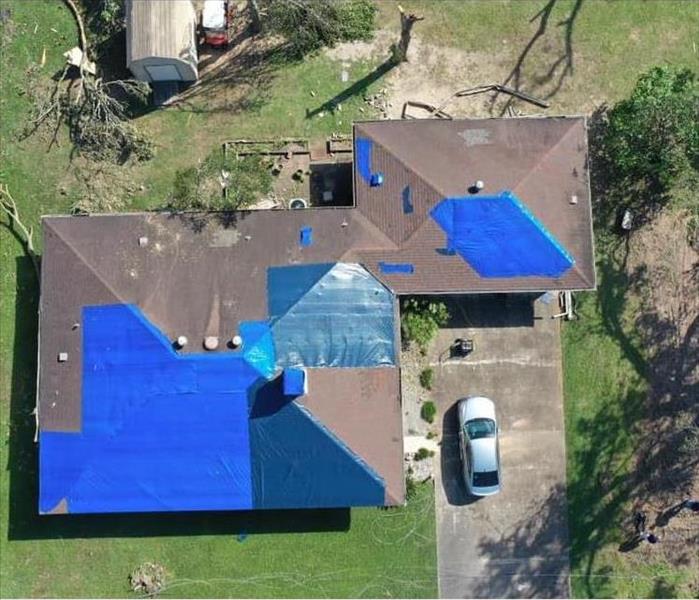 SERVPRO of Lufkin Roof-Tarp and Board-Up Services: Protecting Your Property After a Storm
SERVPRO of Lufkin Roof-Tarp and Board-Up Services: Protecting Your Property After a Storm
SERVPRO of Lufkin Roof-Tarp and Board-Up Services: Protecting Your Property After a Storm
When an east Texas storm strikes, the damage to your home or business can be overwhelming. Protecting your property quickly is crucial to prevent further harm, whether it's a compromised roof, broken windows, or damaged walls.
Why Roof-Tarp and Board-Up Services Matter
Storm damage in Lufkin doesn't stop once the clouds clear. Rain, wind, and even unwanted guests — both animals and people — can take advantage of any openings left behind. That's where our roof tarp and board-up services come in:
- Roof Tarp Service: We provide high-quality roof tarps to cover exposed areas, preventing water damage and protecting your property until SERVPRO of Longview can make permanent repairs.
- Board-Up Service: Our board-up solutions secure broken windows, doors, and walls, keeping your property safe from weather elements, pests, and illegal entry.
Residential Storm Damage Restoration
We know that storms don't wait for business hours, so we don't either. Our service professionals are on call 24/7/365, including weekends and holidays, to help you recover from residential and commercial storm damage.
Our local storm damage services include:
- Residential Flooding and Storm Cleanup
- Severe Weather Damage Restoration
- Wind Damage and Wildfire Cleanup
- Flood Water Removal and Cleanup
When the unexpected happens, you can count on us to respond quickly and work efficiently to restore your property. Don't let storm damage linger — protect your home or business today.
Contact SERVPRO of Lufkin anytime for fast and reliable storm damage restoration (936) 637-0404.
Water Damage Cleanup & Repair in Lufkin Texas: Fast, Reliable, and Always Ready
2/25/2025 (Permalink)
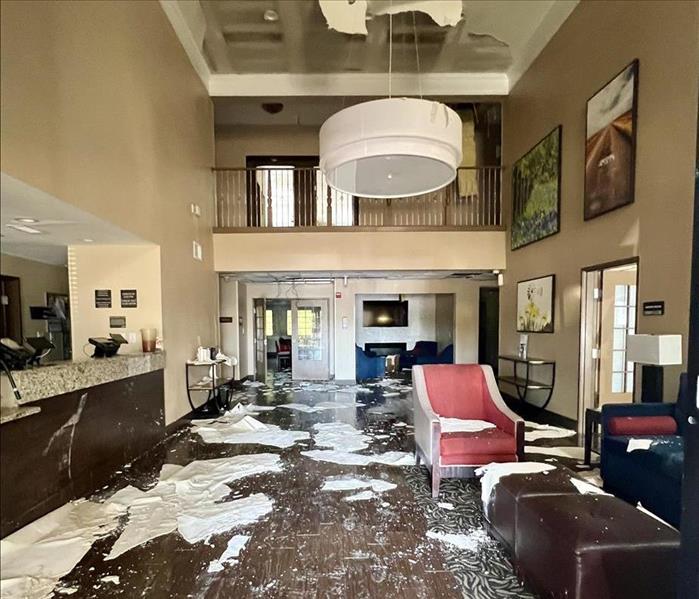 Water Damage Cleanup & Repair in Lufkin, Texas: Fast, Reliable, and Always Ready
Water Damage Cleanup & Repair in Lufkin, Texas: Fast, Reliable, and Always Ready
Water Damage Cleanup & Repair in Lufkin, Texas: Fast, Reliable, and Always Ready
When water damage strikes, every minute counts — and SERVPRO of Lufkin is ready to respond 24/7/365. As the #1 choice in cleanup and restoration, we specialize in residential and commercial water damage restoration near you. Our team is committed to arriving quickly, equipped with advanced water inspection, extraction, and drying equipment to tackle any water-related disaster.
Why Choose SERVPRO of Lufkin for Water Damage Restoration?
Water damage can happen anytime — from a sudden pipe burst, basement flood, sewage backup, or hidden water leak. No matter the cause, we know that acting fast is key to minimizing damage and cost. Our trained professionals are dedicated to:
- Emergency Water Removal: Available 24/7, including weekends and holidays.
- Thorough Damage Assessment: We carefully inspect and identify all affected areas.
- Fast Water Extraction: We remove standing water and detect hidden moisture using top-tier equipment.
- Complete Drying & Cleanup: Our goal is to restore your home or business to its pre-damaged condition quickly and efficiently.
Stress-Free Insurance Claims
We know dealing with water damage is stressful enough without the added hassle of insurance paperwork. That’s why SERVPRO of Lufkin makes the insurance claim process easier by documenting the water removal and cleanup process every step of the way.
Serving the Lufkin Community
As a local storm and water damage restoration company, we take pride in helping our Lufkin neighbors bounce back from unexpected water disasters. We live and work here, too, so your property’s safety and restoration are personal.
When water damage threatens your home or business, remember that SERVPRO of Lufkin is Faster to any size disaster.
Need water removal or flood cleanup? Call us now — we’re here for you 24/7/365.
How SERVPRO® Uses FLIR Meters to Detect Moisture After Water Damage
9/30/2024 (Permalink)
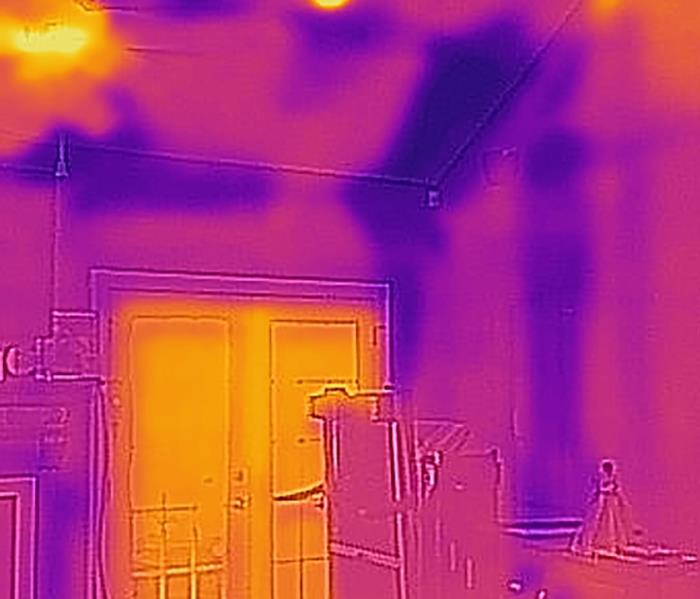 This advanced thermal imaging tool detects moisture by measuring temperature differences in walls, floors, and ceilings.
This advanced thermal imaging tool detects moisture by measuring temperature differences in walls, floors, and ceilings.
After water damage in your home, you need to worry about more than visible water. Hidden moisture can seep into walls, floors, and ceilings, creating the perfect environment for mold growth and long-term structural damage. That’s why at SERVPRO, we use advanced technology like FLIR meters to detect moisture that can’t be seen by the naked eye.
A FLIR meter is a thermal imaging tool that identifies temperature differences in your home’s structure. When water is trapped behind walls or under flooring, it often creates cooler spots, which the FLIR meter highlights with precision. This allows our SERVPRO technicians to accurately identify problem areas and take immediate action, ensuring that every inch of your home is properly dried.
By using FLIR meters, we don’t just restore your home’s surface—we target hidden moisture to prevent further damage and health risks. With this technology, SERVPRO ensures that your home is completely restored, giving you peace of mind and protecting your property for the long term. When you choose SERVPRO, you're not just getting quick service; you're getting thorough, professional care with the best tools available!
The Dangers of Flood Damage Without Proper Mitigation
9/30/2024 (Permalink)
 Proper mitigation not only saves you from costly repairs but also protects the health and safety of your family.
Proper mitigation not only saves you from costly repairs but also protects the health and safety of your family.
Flooding in east Texas is one of the most devastating disasters a homeowner can face. When floodwaters invade your home, they don’t just damage the visible areas; they infiltrate walls, flooring, and even your home’s foundation. While cleaning up the water may seem like a big step, without proper mitigation, the problems caused by flooding can worsen over time and lead to significant, long-lasting damage.
Here’s what can happen if flood damage isn’t properly mitigated:
1. Mold Growth
Floodwaters create the perfect environment for mold to thrive. Within 24 to 48 hours, mold can start growing in damp, hidden spaces such as behind walls, under flooring, and in basements. Left untreated, mold not only damages your property but can also lead to health issues.
2. Structural Damage
Water weakens the structural integrity of your home. Wooden beams, drywall, and flooring can absorb water, leading to warping, swelling, and even rot. Over time, this can compromise the stability of your home’s foundation and framework, leading to costly repairs.
3. Electrical Hazards
Floodwaters can affect your home’s electrical systems. Water exposure to wiring, outlets, or appliances creates a risk of short circuits, electrical fires, and shocks. If water-damaged areas aren't properly dried and inspected, it can result in long-term electrical hazards.
4. Decreased Property Value
Homes with unresolved water damage or mold issues often lose value. Prospective buyers are wary of properties with a history of flooding, especially if there’s visible damage or lingering moisture problems. Proper mitigation ensures your home retains its value and is safe for future residents.
5. Lingering Odors
Floodwater often carries dirt, debris, and contaminants that can leave behind unpleasant odors. Without proper drying, cleaning, and deodorization, these odors can persist long after the water is gone, making your home uncomfortable to live in.
The Importance of Professional Mitigation
Proper flood mitigation goes beyond simply removing water. It involves thorough drying, moisture detection, mold prevention, and sanitization to ensure your home is completely restored. At SERVPRO®, we use advanced tools like dehumidifiers, air movers, and moisture meters to make sure every area of your home is dry and safe. We also handle mold remediation and disinfect the affected areas to keep your family healthy and your home intact.
Don’t let flood damage turn into a long-term disaster. Proper mitigation not only saves you from costly repairs but also protects the health and safety of your family. If your home experiences flood damage, contact SERVPRO immediately for professional, effective restoration. We're here to help you make it "Like it never even happened."
September Weather in East Texas: A Transitional Time and Leaf Raking
9/18/2024 (Permalink)
 Yay, it's cooler autumn weather, but now I am on leaf-raking duty!
Yay, it's cooler autumn weather, but now I am on leaf-raking duty!
September in East Texas brings football, a mix of summer's lingering heat, and the first hints of fall. Early in the month, temperatures often remain in the upper 80s and low 90s, keeping that familiar summer humidity alive. However, as the month progresses, we start to see cooler mornings and evenings, with temperatures gradually dipping into the 60s and 70s, offering a much-needed break from the sweltering summer.
East Texas can also experience scattered thunderstorms during September as summer storms roll through, keeping the area lush and green. These rain showers preview the changing season, making it an ideal time to enjoy outdoor activities, whether a hike through the piney woods or a weekend barbecue.
As we inch closer to fall, September becomes a transition month—still warm but with cooler days on the horizon, signaling that autumn is just around the corner and the leaves are falling!
Ah, the dreaded leaf raking! As beautiful as autumn can be, those vibrant oranges, red, and yellow leaves falling everywhere also signal the start of the annual leaf battle in the yard. So get ready and have fun! :-)
The Hidden Dangers of Falling Trees Near Your Lufkin Texas Home
6/20/2024 (Permalink)
 The Hidden Dangers of Falling Trees Near Your Lufkin Texas Home
The Hidden Dangers of Falling Trees Near Your Lufkin Texas Home
As serene and picturesque as a home surrounded by trees can be, it's essential to recognize the potential risks that come with it, especially the threat of falling trees. While trees offer shade, beauty, and environmental benefits, they can also pose significant hazards if not properly maintained.
The Risks of Falling Trees
1. Property Damage: Falling trees or branches can cause severe damage to your home, vehicles, and other structures. The impact can lead to costly repairs, not to mention the potential for temporary displacement if your home becomes uninhabitable.
2. Personal Injury: The danger extends beyond property damage. Falling trees can cause serious injuries or even fatalities. It's crucial to consider the safety of your family, guests, and pets.
3. Utility Disruptions: Trees falling on power lines can lead to electrical outages, posing a risk of fire and hindering emergency response efforts. Downed power lines can also be extremely dangerous to approach.
Prevention and Safety Tips
1. Regular Inspections: Conduct regular inspections of the trees around your property. Look for signs of disease, decay, or structural weaknesses. Professional arborists can provide thorough assessments and recommend necessary actions.
2. Prune and Maintain: Routine pruning helps maintain tree health and reduces the risk of falling branches. Remove dead or overhanging branches, and consider trimming back trees that are too close to your home.
3. Remove Hazardous Trees: If a tree is identified as hazardous, removal might be necessary. Although this can be a tough decision, the safety benefits often outweigh the sentimental value of the tree.
4. Monitor Weather Conditions: Extreme weather conditions, such as heavy winds, storms, and ice, increase the likelihood of trees falling. Stay informed about weather forecasts and take precautionary measures during adverse conditions.
5. Create a Safety Plan: Have an emergency plan in place for your family. Know where to seek shelter within your home and have an emergency kit ready in case of power outages or structural damage.
Conclusion
While trees add significant value and beauty to your property, it's crucial to stay vigilant about the risks they can pose. Regular maintenance, professional assessments, and a proactive approach to tree care can help ensure that your home remains a safe and beautiful haven.
By taking these steps, you can enjoy the benefits of having trees around your home while minimizing the risks associated with falling trees. Stay safe and proactive, and your leafy neighbors will continue to be a source of joy rather than worry.
Call SERVPRO of Lufkin anytime for emergency services 27/7/365 at 936-559-0404
Provide a Healthy Summer for Your Pet
6/1/2024 (Permalink)
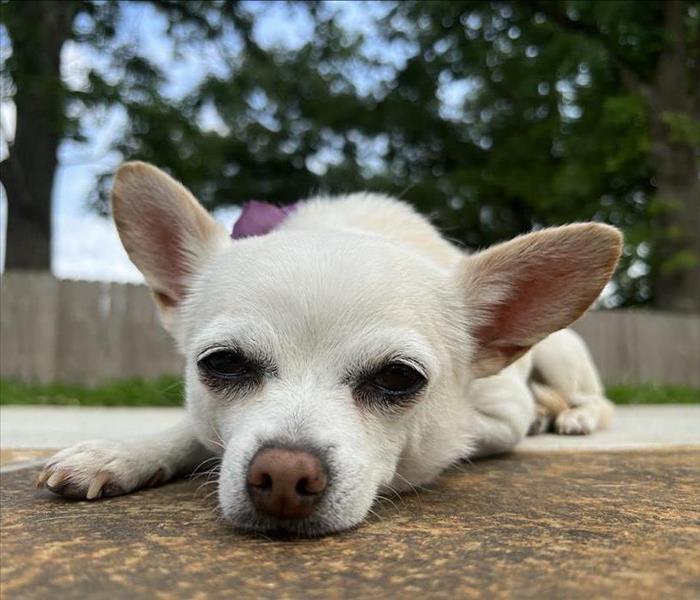 Don't worry about me; I'm just lazying by the pool and enjoying my best dog life!
Don't worry about me; I'm just lazying by the pool and enjoying my best dog life!
As the temperatures rise and the sun shines brighter, we must ensure that our beloved furry friends stay cool, hydrated, and happy during summer. Whether you have a loyal dog, a playful cat, or a chirpy bird, here's a comprehensive guide to keeping your pets healthy and safe this summer.
1. Hydration is Key
Just like us, pets need plenty of water to stay hydrated, especially in the summer heat. Provide fresh, clean water at all times, and consider adding ice cubes to their bowl to keep the water cool. If you're taking your pet for a walk or on an outdoor adventure, bring a portable water bottle and a collapsible bowl to ensure they stay hydrated.
2. Protect Against Heatstroke
Pets can easily suffer heatstroke if exposed to high temperatures for too long. Keep them cool by providing access to shade when outdoors, and avoid exercising them during the hottest parts of the day. If you notice signs of heatstroke, such as excessive panting, drooling, or lethargy, immediately move your pet to a cooler area and contact your veterinarian.
3. Never Leave Pets in Parked Cars
Even with cracked windows, cars can quickly become dangerously hot for pets. Never leave your pet unattended in a parked car, even for a short period. On a hot day, the temperature inside a car can rise to dangerous levels within minutes, putting your pet's health and safety at risk.
4. Provide Proper Shelter
If your pet spends time outdoors, make sure they have access to adequate shelter to protect them from the sun and heat. This could be a shaded area in your backyard or a well-ventilated doghouse. Ensure that their shelter is spacious, well-insulated, and equipped with fresh water to help them stay cool and comfortable.
5. Practice Safe Exercise
While keeping your pet active is important, be mindful of the temperature and humidity levels when exercising outdoors. Opt for early morning or late evening walks when temperatures are cooler, and avoid hot pavement or asphalt that can burn your pet's paws. If your pet enjoys swimming, consider taking them to a pet-friendly beach or pool for a fun and refreshing activity.
6. Grooming and Sun Protection
Regular grooming is essential for helping your pet stay cool and comfortable during the summer months. Brushing their fur helps remove loose hair and prevents matting, which can trap heat close to their skin. Additionally, consider using pet-safe sunscreen on areas of exposed skin, such as the nose, ears, and belly, to protect them from sunburn.
7. Watch Out for Pests
Summer brings out pesky pests like fleas, ticks, and mosquitoes, which can pose health risks to your pet. Make sure your pet is up-to-date on flea and tick prevention, and consider using pet-safe mosquito repellents if spending time outdoors. Regularly check your pet for signs of fleas or ticks, such as excessive scratching or redness, and consult your veterinarian for appropriate treatment options.
By following these tips and prioritizing your pet's health and safety, you can ensure they have a happy and healthy summer season. Whether you're lounging in the backyard, hiking, or enjoying a day at the beach, keeping your pet cool, hydrated, and protected will make for a summer filled with unforgettable memories and endless fun. Stay tuned for our upcoming series on specific pet care tips tailored to dogs, cats, birds, and more!
Summer Safety and Enrichment for Kids: Tips for Parents
5/3/2024 (Permalink)
 A DIY science project is always fun on a rainy day!
A DIY science project is always fun on a rainy day!
With school out for the summer, many of us look forward to fun-filled days and memorable adventures with our children. However, amidst the excitement, ensuring that our kids stay safe and engaged in enriching activities is crucial. Here are some tips and suggestions to help you navigate the summer months while keeping safety a top priority:
1. Outdoor Safety: Encourage outdoor play, but make sure children wear sunscreen, stay hydrated, and take breaks in the shade. Remind them about road safety when biking or playing near roads.
2. Water Safety: Supervise children closely around water, whether it's a pool, lake, or beach. Ensure they wear appropriate floatation devices if needed and know basic water safety rules.
3. Home Safety: Conduct a thorough safety check of your home. Ensure that smoke and carbon monoxide detectors are working properly. Teach kids about fire safety, including how to exit the house safely in case of emergency.
4. Summer Enrichment: Keep children engaged with educational and enriching activities. Visit the local library for summer reading programs, explore nature trails, or enroll them in educational camps or workshops.
5. Creative Activities: Encourage creativity through art projects, DIY science experiments, or cooking together. These activities not only entertain but also promote learning and development.
6. Limit Screen Time: Set boundaries on screen time and encourage outdoor play, physical activities, and face-to-face interactions with friends and family.
7. Chores and Responsibilities: Assign age-appropriate chores to teach responsibility and encourage participation in the household. These can include gardening, pet care, or helping with meal preparation.
8. Community Engagement: Get involved in community events or volunteer opportunities. It's a great way for children to learn about giving back and making a positive impact.
9. Family Time: Schedule regular family outings or game nights to strengthen bonds and create lasting memories together.
10. Emergency Preparedness: Review emergency procedures with your children, including who to call in case of emergencies and how to respond to different situations.
Safety should always come first, but summer is also a time for fun and exploration. Following these tips and staying vigilant can ensure our children have a safe and fulfilling summer vacation.
Wishing you a wonderful and safe summer!






 24/7 Emergency Service
24/7 Emergency Service





